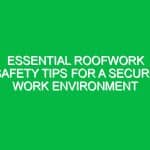Introduction
Good morning, team! Today, we’re here for our Toolbox Talk to discuss an essential topic that affects each of us: Unsafe Conditions in the Workplace. Understanding what constitutes unsafe conditions, how to identify them, and how to mitigate risks is crucial to our health, safety, and overall productivity. We all play a vital role in maintaining a safe working Environment, and our discussion today aims to enhance our awareness and knowledge about these unsafe conditions.
Defining Unsafe Conditions in the Workplace
Unsafe conditions refer to any situation or environment that poses a risk of injury, illness, or harm to employees. These conditions can stem from various sources, including physical Hazards, environmental factors, and operational practices. Examples include:
- Poor housekeeping: Cluttered workspaces can lead to slips, trips, and falls.
- Inadequate Personal Protective Equipment (PPE): Failure to use or provide proper PPE can expose employees to hazardous substances or environments.
- Unsafe machinery: Equipment that is not properly maintained or operated can cause serious accidents.
- Excessive noise: Working in noisy environments without adequate hearing protection can lead to long-term health issues.
Recognizing these unsafe conditions is the first step toward fostering a safer workplace.
The Importance of Identifying Unsafe Conditions
Identifying unsafe conditions in the workplace is not just a regulatory requirement; it’s a moral obligation. The importance of this process can be illustrated through several key points:
- Prevention of Accidents: By identifying and addressing unsafe conditions, we can significantly reduce the likelihood of accidents and injuries.
- Boosting Morale: A safe work environment enhances employee morale and productivity. When employees feel safe, they are more likely to be engaged and focused on their tasks.
- Compliance with Regulations: Understanding and addressing unsafe conditions ensures compliance with health and Safety regulations, which mitigates legal risks.
- Protecting Company Reputation: Companies known for prioritizing Safety attract top talent and maintain a positive image.
Common Unsafe Conditions and How to Address Them
Let’s delve into some common unsafe conditions you might encounter in our workplace and discuss practical ways to address them:
Poor Housekeeping
Poor housekeeping can lead to accidents such as slips, trips, and falls. To address this, we should:
- Keep walkways clear of obstacles.
- Regularly clean spills immediately.
- Organize tools and materials in designated areas.
Inadequate Personal Protective Equipment (PPE)
Not using proper PPE can expose you to various Hazards. Here’s how to remedy this:
- Always wear the required PPE for your specific tasks.
- Report any missing or damaged PPE immediately.
- Participate in Training sessions on the correct use of PPE.
Unsafe Machinery
Operating unsafe machinery can cause severe injuries. To ensure safety:
- Conduct regular Maintenance checks.
- Follow operational guidelines and training protocols.
- Report any malfunctions or safety concerns to your supervisor.
Excessive Noise
Working in noisy environments can lead to hearing loss. To protect your hearing:
- Use ear protection when necessary.
- Limit exposure to loud environments as much as possible.
- Participate in noise assessments if offered by the company.
Real-Life Examples: Learning from Others
Understanding unsafe conditions can often be made clearer through real-life examples. Let’s consider a couple of scenarios:
Scenario 1: Warehouse Safety
In a busy warehouse, an employee noticed that boxes were stacked too high on a shelf. Despite their concerns, they didn’t report it, fearing it might seem trivial. One day, a box fell and injured a coworker. This incident could have been avoided if the employee had taken the initiative to report the unsafe condition. Remember, there’s no such thing as a trivial safety concern.
Scenario 2: Construction Site
On a construction site, workers were often seen without hard hats. The supervisor noticed this but didn’t enforce the safety rule. Unfortunately, a falling object caused a serious injury. This incident highlights the importance of enforcing safety protocols and ensuring that everyone understands their responsibilities in maintaining a safe work environment.
Best Practices for Maintaining Workplace Safety
To effectively manage and mitigate unsafe conditions in the workplace, consider implementing these Best Practices:
- Regular Training: Participate in regular safety training sessions to stay updated on Best Practices and safety protocols.
- Open Communication: Foster an environment where employees feel comfortable reporting unsafe conditions without fear of reprisal.
- Conduct Safety Audits: Regularly conduct safety audits to identify potential hazards and unsafe conditions.
- Engage Employees: Involve employees in safety discussions and decision-making processes to enhance their commitment to safety.
Regulations and Standards
Compliance with health and safety regulations is crucial in addressing unsafe conditions in the workplace. Familiarize yourself with the following:
- Occupational Safety and Health Administration (OSHA): osha sets and enforces standards to ensure safe working conditions.
- National Institute for Occupational Safety and Health (NIOSH): NIOSH conducts research and makes recommendations for the Prevention of work-related injury and illness.
- Company Policies: Each organization has specific policies regarding safety practices that must be followed. Make sure you are familiar with them.
Understanding these regulations not only protects you but also reinforces the company’s commitment to safety and legal compliance.
Conclusion
In conclusion, recognizing and addressing Unsafe Conditions in the Workplace is a shared responsibility that each of us must take seriously. By identifying hazards, following best practices, and adhering to regulations, we can create a safer work environment for everyone. Remember, your safety is paramount, and your contributions to safety discussions are invaluable.
Thank you for your attention today and for your ongoing commitment to safety. Let’s continue to look out for one another and ensure our workplace remains safe and productive. Are there any questions or concerns you’d like to discuss?


